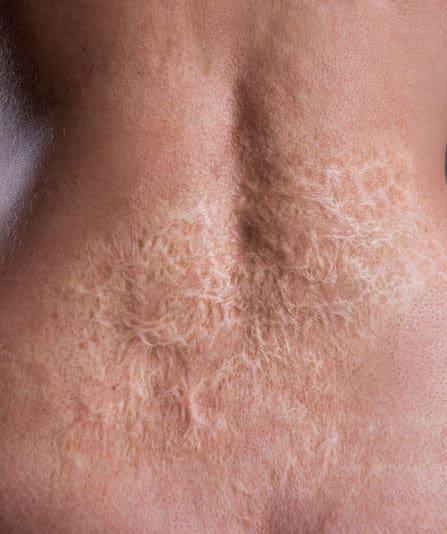Scars by Mr Ioannis Goutos
Tight scars

Tight scars, or scar ‘contractures’, are a particularly bothersome type of scarring that typically occurs following an injury to a large area of skin, such as a burn. When there is damage to the skin, it repairs itself using its own healing mechanism, which will inevitably result in scarring. The scar is formed by the laying down of connective tissues, such as collagen, and the regeneration of skin cells to repair the broken skin. This process aims to restore the integrity and function of the skin. If the initial damage occurs over a larger area of skin, as the scar forms, sometimes the edges of damaged skin are pulled together, causing the resultant scarring to have a higher degree of tension than the surrounding skin and feel tight.
This contracture within the skin can be unsightly, cause a number of distressing symptoms and limit the function of the underlying muscles and joints. The tighter skin can also cause long term pain or itching.
Mr Ioannis Goutos is a top London-based plastic surgeon with a special interest in helping people who are suffering from scars and burns. He is a skilled surgeon who places particular attentions on all aspects of patient care: physical, social and psychological. With his prominent academic profile in the area of scars and burns, he is well placed to provide gold standard advice and a range of treatment options and aftercare individual to you and your skin.
Book your consultation today
Book nowAbout this condition
Contracture scar tissue typically contains a higher proportion of the tough collagen tissue than regular scarring; this, combined with the shortening of the scar tissue over a wider area, results in scar tissue which is tough and tight. It can also involve some of the deeper layers of tissue under the skin, such as the myofascial layer (tissue that attaches the skin to the muscle) and surrounding nerves and blood vessels. This can result in mechanical shortening and loss of elasticity in the skin meaning that the movement of the underlying muscle groups and joints becomes restricted. This can be painful, and also have effects on the circulation of blood flow and lymphatic drainage of that area. If these additional structures are affected by tight scarring, treatment can become extremely difficult and requires specialist input, usually from a multidisciplinary team with experience in managing challenging scars.
Physiotherapy is key to maintaining function whilst healing from significant burn injuries that may result in contracted scarring. By exercising and stimulating low force but repetitive tension, this can help to improve the overall flexibility in the final scarring and retain a good range of movement in any affected joints. There are additional surgical options that can help to improve the appearance and function of tight scars:
- Tissue expander – a device which is used to help stretch the target area of skin over a period of weeks to months.
- Incision through the contracture, with the option of moving neighbouring skin into the gap created in the scar, called a flap.
- Surgical removal (excision) of the tight scar, also with the option of skin grafting.
- Z-plasty – cutting through the tight scar tissue in a ‘z’ pattern to allow the scar tissue to be interposed with normal skin. This aims to reduce the tension within the scar
Isolated skin grafting or free flap coverage.
The management of tight or contracted scars is highly specialised and it is key to ensure that you consult with an experienced clinician. They may recommend particular treatments or a combination of strategies guided by your skin, symptoms and goals.

Testimonials
Mr Goutos is delighted to share some of his patient and peer feedback on their experiences of his services.










